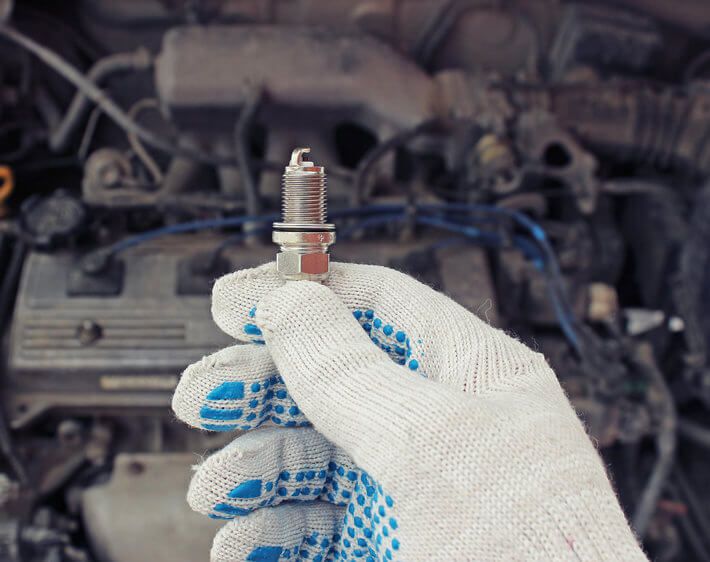Many drivers assume that when their car has trouble starting, there’s a problem with the battery. While this could be the issue, it’s not the only possibility. Old or worn spark plugs could be the culprit! After all, these small components have a big job to do.
Spark plugs may be small, but they pack a punch when it comes to your car’s performance. Learn when to change spark plugs by watching for these bad spark plug symptoms.
What are Spark Plugs and What Do They Do?
Spark plugs are insulated plugs that play a crucial role in a vehicle’s internal combustion engine. They screw into the cylinder head that sits at the top of the engine, and they're only about the size of a finger. Every time you start your car, they create a small but powerful spark that ignites the air-fuel mixture in the combustion chamber. The combustion process, burning fuel with oxygen, is what powers the engine.
What Makes a Spark Plug Go Bad?
Spark plugs are built to last, but they’re not invincible. Over time, several factors can contribute to a spark plug going bad:
Wear and Tear: Like any other part, spark plugs experience wear and tear over time. The constant exposure to high temperatures and the continuous sparking process eventually wear down the electrodes, reducing the effectiveness of the spark.
Carbon Buildup: If your engine is running too rich (meaning there’s too much fuel and not enough air in the mixture), carbon deposits can accumulate on the spark plugs. This buildup can insulate the spark plugs, preventing them from firing correctly.
Oil-Soaked or Fouled: Worn piston rings or valve guides can allow oil to enter the combustion chamber, causing an oil-soaked or fouled spark plug. When spark plugs experience either of the two, they won’t ignite the fuel mixture as effectively. This can lead to poor engine performance—one of the most common symptoms of a fouled spark plug.
Overheating: Overheating can cause the spark plug’s electrodes to wear out more quickly. This is often due to issues like incorrect spark plug gap, poor fuel quality, too little fuel available for combustion, or engine overheating.
Incorrect Installation: If spark plugs are not installed correctly or if the wrong type is used, they can fail prematurely. Proper installation is crucial to ensuring the longevity of your spark plugs.
Because spark plugs bring power to your engine, they influence your engine's performance, efficiency, and emission levels. Spotting the signs of bad spark plugs early and replacing old plugs to keep your engine working properly is crucial.
Signs of Bad Spark Plugs
So, how do you know if your spark plugs are going bad? There are several telltale signs that something’s not right under the hood:
1. Your check engine light comes on
Worn/failed spark plugs, coil packs, or spark plug wires can trigger your check engine light to come on. In today's cars, if a spark plug fails and can no longer ignite the air-fuel mixture, then the most obvious event should be the check engine light coming on or even flashing. A flashing engine light could indicate potentially catastrophic misfires, which could damage the catalytic converter(s).
2. Engine misfires
One of the most common symptoms of bad spark plugs is engine misfires. If a spark plug isn’t firing correctly, the engine’s combustion process is disrupted, causing the engine to stutter or jerk, especially during acceleration.
3. Your car has trouble starting
Your spark plugs have one of the most important jobs in your vehicle, which is to provide the spark that powers the engine! Old, worn out spark plugs have a harder time creating the spark that actually powers your engine. If you experience an extended crank time or the car stalls right after start-up, there could be a problem with spark plugs or damaged spark plug wires. The battery is most likely the culprit if your car has no power and won't start at all.
4. Bad gas mileage
Spark plugs also play a role in maintaining your car’s fuel efficiency. When they’re working correctly, they help ensure that fuel is burned efficiently. But if your spark plugs are on their last leg, they’ll take it out on your gas mileage.
Worn-out spark plugs can increase your vehicle’s fuel consumption because they won’t effectively burn the fuel that goes into the engine, meaning you’ll be shelling out more money on fill-ups.
5. The engine idles roughly (and you can hear it!)
Typically (hopefully!), your engine purrs like a kitten, but turn down your music and take a listen. If you notice that the engine is making rattling, pinging, or knock-like noises, your spark plugs might be to blame.
6. Your car won’t accelerate quickly
You’re probably pretty familiar with how your vehicle handles and drives. If your car doesn’t accelerate as quickly as it used to or feels sluggish, this could be traced back to worn spark plugs. Without a strong spark, your engine may not produce the power needed for quick acceleration.
In this instance, it might be time to have them replaced – no one likes driving a sluggish, fuel-guzzling car.
How Long Do Spark Plugs Last?
Luckily, spark plugs don’t wear out very quickly. But their lifespan can vary depending on the type of plug and your driving habits. Typically, you can get maybe 80,000 miles on them before they need replacing. But if you notice any of these symptoms, it’s time to get your spark plugs checked out.
When to Replace Spark Plugs
In any car care matter, it's always best to follow the manufacturer's suggested maintenance schedule. This can help save you from costly repairs, as driving with misfiring spark plugs could put undue stress on your car's catalytic converter (the engine's exhaust cleaner).
Review your vehicle's suggested maintenance schedule to see when to replace your spark plugs.
What Does a Bad Spark Plug Look Like?
So, how can you tell if a spark plug has lost its pep? In addition to the symptoms mentioned earlier, there are some visible signs you can look for to determine if a spark plug is bad:
Carbon buildup
Look for debris buildup or black, sooty deposits around the tip of the spark plug. Sometimes simply removing and cleaning off a dirty spark plug with carbon cleaner and an abrasive, like a wire brush or sandpaper, may help its performance, but the electrode gap will need to be verified before reinstalling. However, if you've already taken the steps needed to remove the spark plugs, it’s best to just replace them.
A worn electrode
At the bottom of the spark plug—the part screwed into the combustion chamber—is a small metal piece that looks like a dome with a J-shaped piece of metal over it. The J-shaped piece is the ground electrode, and the dome is part of the central electrode that runs the length of the spark plug. These electrodes will wear after years of igniting air and fuel in the combustion chamber. Melting and erosion around these electrodes is a sign a spark plug has gone bad.
A cracked insulator
Take a look at the insulator. It’s the white ceramic casing extending from the seal to the terminal of the center electrode. If you notice any cracks or chips, even as slight as a hairline crack, this can prevent a spark plug from controlling the flow of electricity through the terminal to power your engine. A cracked insulator cannot be fixed, and the spark plug will need to be replaced.
Oil fouling
A spark plug with oily deposits on the insulator tip and electrodes is a classic fouled spark plug symptom, which could point to an internal engine oil leak. This oil can prevent the spark plug from firing properly, leading to engine performance issues. Locating the source of this issue is a priority as it can point to more serious concerns—stop by Firestone Complete Auto Care for assistance.
Can You Drive with Faulty Spark Plugs?
Faulty spark plugs can lead to a range of issues that can cause long-term damage to your engine. If left unchecked, bad spark plugs can even lead to more expensive repairs, such as replacing the catalytic converter, so don’t put it off. Make an appointment at your local Firestone Complete Auto Care so our technicians can see exactly what’s going on!



